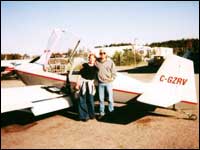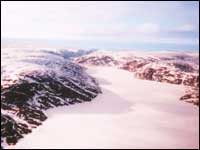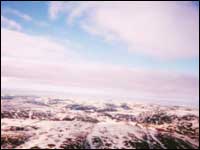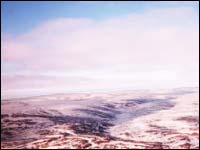 | Originally published on the Discovery channel website | ||||||||
| Setting a speed record from Ottawa to Iqaluit October 21, 1999 | |||||||||
|
There were three purposes for the flight. First, I have never had the opportunity to travel and stay in the North. Great expanses of Canada are considered North and so many of us just never get to see the beauty of the land and the people. Secondly, I wanted to give my daughter a real feeling for the geography of her homeland and hopefully greater understanding of the distances and topography involved when looking at a map of Canada. The third reason was to create a world speed record between Ottawa and Iqaluit. I currently hold several other National and World speed records between provincial Capitals. They arent really all that important or impressive. My purpose is to promote aviation in Canada. If one other person climbs into an airplane to break or set an aviation record, I feel I have been successful in some small way. Besides that, I find the pre-planning and the flight itself just plain fun! I would never have attempted this adventure without some level of confidence in my aircraft. I was planning on taking a cherished family member and myself into some really rugged and inhospitable areas. I have over 450 hours of trouble free flying since I completed my aircraft, a Vans RV-6, in April 1997. I have done four 100-hour inspections, and kept careful records of the engine history. I had no reason to expect anything less than flawless operation. With that said, it is still only a machine. I needed to make some important preparations before we could go, of which the most pressing item was fuel. The aircraft currently holds 140 liters of avgas, which allows about four hours of running time. One of the personal restrictions I placed on the flight was the ability to return from any part of a flight leg and land at the original departure point with reserves of gas on board. I determined what routing would take me to airports where avgas was available. Five and half-hours of fuel would satisfy my self-imposed rule when I was in the most uninhabited regions. With that I securely installed a 48-liter polypropylene tank in the baggage compartment. An aircraft fuel cap and mounting flange was installed on the tank for a completely leak free installation. I was very hesitant about modifying a proven fuel system, so I left the left main tank plumbing alone. The unmodified tank would be used for take off and landing. The auxiliary tank was plumbed in between the right tank and selector valve with another 3-port valve. A separate overboard venting system was also used. The results were quite satisfactory. The extra tank and plumbing can be installed or removed in about 20 minutes. Total fuel available is now slightly over 5.5 hours.
Months earlier I had made contact with Bert Rose, a resident of Iqaluit, through the Internet. Bert and two other gentlemen are partners in a Cessna 172 based at Iqaluit. I was in constant contact with Bert and his partners from November 1998 on. With their input, a routing and time of year was established. June is normally good VFR flying in the north, with the added benefit of extended daylight hours. As the departure date moved closer, Bert kindly offered to open his home for Lauren and I. On Thursday June 3, Lauren and I left Kitchener for Ottawa. I was taking a gamble that the bad weather Central Quebec was forecasting would not materialize. We stayed over night at the Monterey Inn, not far from the Ottawa Flying Club where ZRV was tied down. The weather briefing at 6:00AM the following morning looked good and we were off to the airport. Bruce and Eunice Carter met us at the Flying Club. Bruce is the secretary for the Canadian Sport Aircraft Association and was there to act as official observer for the departure. At 8:55AM we departed Ottawa for Wabash, Labrador. This first leg was the longest one and would leave me with 1.5 hours of fuel on landing. This was quite acceptable because of the number of airports available to us in the southern half of Quebec. We touched down at Wabash 4.2 hours after leaving Ottawa. As Lauren ate lunch in the terminal building, I fueled up and answered lots of questions from curious pilots.
The weather to the northwest along our path wasnt quite as pleasant as the first part of the flight. Ceilings were at about 4000 feet and we ran into some light snow showers. Visibility stayed about ten miles so I wasnt to alarmed. We crossed three airports before arriving at our jump off point on the Hudson Strait. Two of the airports were gravel strips in the middle of nowhere. No services were available at any of them. The last of the trees disappeared and gave way to barren black rock and snow. As we approached the shore, we were encouraged to see the coastline of Baffin Island 80 miles away. The low ceilings we were under ended about 40 miles across the Strait. Lauren looked in amazement at the ice floes and icebergs down below. Thirty-five minutes later we were across the Strait and flying over the most incredible, beautiful land we have ever seen. The flight into Iqaluit was over much to quickly. Bert and crew were waiting for us at their hangar acting as the official welcoming committee. Lauren quickly became chilled in the brisk wind and 3C temperatures and she was wrapped in a blanket and placed in Berts car for warmth. We had left summer temperatures only 10 hours before. After tucking ZRV into the hangar and completing the speed record paperwork with the FSS specialist we were treated to caribou burgers at the Rose home. Lauren was quite apprehensive about the burger, but after a little coaxing, tried it and loved it. We stayed for two days at Chez Rose where the food was plentiful and delicious. Northern hospitality is very special indeed. We toured the town at midnight in bright twilight. It never did get dark and I woke up often through the night unable to reconcile the time on my watch with what I was seeing outside. On Saturday, while my daughter chatted with her friends back home via the internet, I had the opportunity to give some demo rides in my airplane. Most of us aircraft homebuilders are the factorys best advertisers. I never miss a chance to act as an ambassador for flying and building aircraft, especially the Vans series.
The trip out of Iqaluit and across Hudson Strait was accomplished at 10500 feet in the brightest sunniest day yet. The white ice in the mountains and the deep blue Arctic water left us speechless. The brisk north wind pushed our speeds up over 175 knots and Baffin was left quickly behind. Our optimism quickly changed as we approached Kuujjuaq and worsening conditions. We landed in cold rain with fog to the south and lowering ceilings. Time to tie down and find a warm room. Kuujjuaq has some of the best pizza Lauren and I have ever tasted. We know ... we almost finished off a large one all by ourselves. Monday morning looked a little better to the south with conditions forecast to get better through the period. Our first leg was to La Grande-4 and on to La Grande Riviere with planned time of 2.4 hours. The clear pleasant conditions rapidly changed as we approached LG-4. The ceiling was getting lower and the ground fog was getting thicker. I could envision us flying towards the narrow point of a wedge. I was unable to raise the FSS at LG-4 on the radio because of our altitude and distance from the station. We backtracked about thirty miles to climb over the layer and fly back closer to LG-4. I was able to make contact and determine that both fields were covered in heavy fog. Laurens face fell when I told her we might have to return to Kuujjuaq. I circled for a minute mulling over my options. I calculated that Val Dor was 482nm to the south and I had 4 hours of fuel on board. The big tailwind was pushing us to speeds over 180 knots. With Val Dor reporting great weather and forecasting for the same, it was a no-brainer decision. Total flight time from Kuujjuaq to Val Dor was 2.3 hours and I had 50 liters of fuel in reserve when we landed. We crossed the entire Province of Quebec in one leg. We arrived back in 27C temps wearing heavy clothing suitable for late winter. The final leg was to North Bay, Muskoka and Kitchener. I have become very attached to flying over airports since going to Baffin Island. After contacting North Bay FSS and being informed of major thunderstorms in our path, we landed in North Bay to wait them out. Lauren was quite homesick and anxious to keep going, but realized it was better to wait out the severe storms while we were safely on the ground. Three hours later we were on our way home through hazy air. What a difference from the 100+ mile visibilitys of the Arctic. Monday night we slept in our own beds after viewing some of the 3 hours of videotape we captured. It was a father/daughter adventure of a lifetime. We saw some of the most beautiful scenery on this earth. We met and made friends with some wonderful people and I set a new world speed record from Ottawa to Iqaluit. Life is grand!
|
|||||||||



